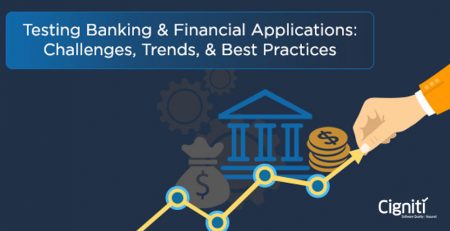How Banks are embracing technology for quality@speed
The disruptive new entrants, challenger banks, and FinTech service providers are revolutionizing the banking sector. We are looking at a future where technology will drive the banking services and become the main attractant for retail banking customers. The situation is as if the legacy infrastructure of the banking incumbents is repelling both new as well as existing customers. As a matter of fact, more than half of the consumers prefer to open a new checking account digitally.
PwC, in their Retail banking 2020: Evolution or Revolution report, predicts that in 2020, every bank will be a direct bank and branch banking will be undergoing a significant transformation. The competitive reach of a bank will no longer be determined by branch networks, rather by banking licenses, technology, and advertising budgets. More than 50% of the banks are planning to enhance their internal capabilities for fostering innovation. There is a wider recognition of the fact that to reap the benefits of innovation, banks will need to develop partnerships and third-party relationships.
Paul Trotter, Dy. CTO at Atom bank, and Nanda Padmaraju, Head of the UK&EU business units at Cigniti, spoke on our recent podcast about how banks are embracing newer technologies like cloud and how quality assurance is helping such banks achieve ROI and other benefits of digital transformation. This blog is an excerpt of their deep-dive discussion on QATalks podcast.
The need for smart data centers and cloud computing
Cloud makes for a cost-effective and flexible solution that enables banks to get control of the speed of changes in the market and to scale up and scale down as per the customer demands. Paul says, “If you are going to move to the cloud, you don’t just want to move your data center. You need to move your products and your components to actually cloud-native so you can utilize the features as part of it so that then you can work through the pace of change.”
Traditionally, banks have been reluctant to use the cloud mainly because of four roadblocks – regulations, data security, third-party risks, and transformation challenges. As regulations get more comfortable, the other three roadblocks are getting cleared out for the banks trying to advance in their digital journey.
Quality engineering across the software development lifecycle
Paul believes that quality engineering is very important, particularly in a bank. As everything that goes live has to be stable, it has to be secured and it should work. As against the old data centers, cultures, waterfall model, and piles of work toward the end of the cycle, cloud-enabled quality engineering allows teams to move ahead and not get stagnated at any point. With the help of the cloud, it becomes possible to build on the DevOps teams and make testing not only earlier but also continuous. Both functional and non-functional testing can initiate as soon as the testbed is integrated into the cloud, thus facilitating early detection of defects and fulfillment of the requirements.
Paul recommends, “From a software development lifecycle perspective, we need to be careful about methodologies and what is really important. DevOps is part of the cloud. The environments that open up to enable you to effectively shift left from both functional and non-functional perspective so that you can truly do very short sprints, all the way through production rather than short spreads that then stop and get formed into some big monster release.”
Quality engineering is about implementing automation and gaining the power of predictability. It is about building a regression test early in the SDLC and having the ability to run a 15-minute test before integrating a code into the branch. With the help of data points and analysis, quality engineering offers a test predictive perspective which can help to prioritize the tests in order to get the right difference.
The importance of Quality Assurance for banks
As the digital-only banks and challenger banks are pushing the status quo and setting new benchmarks in terms of adopting latest technologies and accelerating time to market, the legacy banks are being forced to accelerate their own pace of digital transformation.
Nanda states, “Every bank today has an app for its customers, both on iOS and Android. The customer is oblivious to the fact that there are legacy applications running with most of these banks and expects a superior customer experience for all of their transactions. Customers have zero-tolerance these days and can quickly vent their anger on various social media platforms. In this backdrop, testing the functional and non-functional aspects thoroughly, and embedding quality engineering early on in the lifecycle is extremely important and imperative for the banks to succeed in this digital age. So, QA and QE are the top order in terms of a CTO or a CIO level risk in today’s board-room meetings.”
The possibility of quality and speed at the same time
In the world of legacy data centers and a limited number of environments, it takes a long time to implement a change and there is practically no option but to choose quality over time because if an issue arises, it will take a longer time to fix it. However, if the SDLC moves by quality then by the time it goes live, it becomes irrelevant as everything else has moved ahead.
With the cloud, Agile, DevOps, and quality engineering, it becomes possible to achieve both quality and speed. Paul elaborates as, “This is because we want something, and we don’t know exactly what it is going to be like, but we know what it should feel like. We need space to go and implement that quickly, and then tailor it and then just keep on tuning it effectively, rather than making changes which are big and cumbersome and takes too long to do. Quality at speed is only possible, though, if you’re actually confident around wherever the changes have been made, what the impact of those changes are, and actually what the likelihood is if any issues are born, and the fact that if there was one, you can fix it instantly. And, that’s why it’s fair.”
Cloud migration, quality engineering, and test automation
Quality engineering provides the ability to run things in parallel to production from a non-functional perspective and triage defects quicker. As Agile and DevOps become mainstream, test automation becomes a foundational pillar that acts as an enabler to achieve the end objectives.
Having worked with several clients in the BFSI sector, Nanda ascertains the foundational status of test automation by saying, “The IP and the reusable assets such as test automation frameworks, test environment health check kits, and test data generators, that we bring to the table significantly lower the break-even point in test automation and enhance the ROI over the life cycle for the customers. And particularly for banking, moving to the cloud helps them to achieve speed and agility. Without test automation, you would become the roadblock or the dead-end for customers.”
To sum up
For digital-only banks, it is essential that the one channel through which they offer their services is always available with the right services as required by the customers. Paul advises, “We don’t need to become expert at everything. We just need to be experts at the right things and then stay current so that the customers can feel and experience exactly as they would be expecting. So, know when you should be using the software and how to configure the software. And, absolutely making certain that the data is used appropriately so that the service, the quality, and experience for the customer is all improved as you go along. In terms of choosing components, that’s largely based on what’s the real benefit.”
Noting the benefits that customers have realized by partnering with Cigniti, Nanda says, “Cigniti has proven methodologies to embed shift left and shift right into the overall software test life cycle within the DevOps. We have tool partnership with various commercial toolsets and are a big proponent of embracing open source technologies. So, customers have significantly benefitted from selecting the right tool of their choice at various points in their journey, which suit the underlying technology application and landscape and their own roadmap. Cigniti has global patents and believes in intellectual property and puts that intellectual property to use for its customers.”
At Cigniti, we facilitate seamless migration of test assets from commercial toolsets to open-source toolsets, help customers harness the actual feedback from the end-users into the quality engineering lifecycle for our customers through sentiment analyzer, and accelerate time to market by embracing a comprehensive test strategy.
Schedule a discussion with us to realize how we can help you realize these benefits.





Leave a Reply